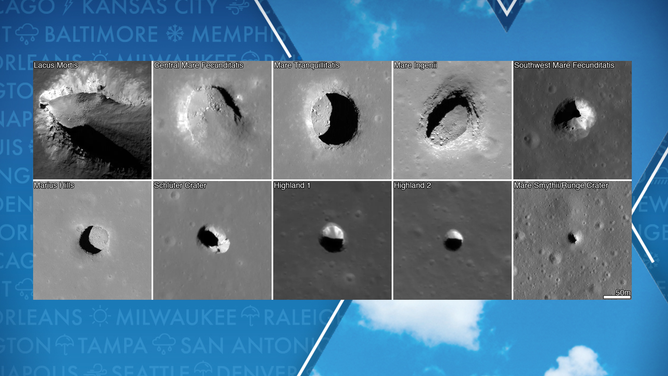Scientists uncover evidence of caves underneath Moon’s surface
Orbiting some 238,855 miles away from Earth, the Moon is the planet’s only natural satellite. NASA’s Artemis III mission is scheduled to carry astronauts to the Moon no earlier than September 2026.
See what's new in the journey to reach the Moon
What's next for exploration of Earth's only natural satellite.
Researchers reexamining data collected from decades of exploration of the Moon’s surface now believe a complex system of caves exists that could impact future missions.
NASA said the lunar caves likely formed when molten lava once flowed beneath the surface, leaving behind lengthy, hollow tunnels.
One of the pits is located approximately 230 miles away from the Apollo 11 landing site, where astronauts Neil Armstrong and Edwin "Buzz" Aldrin landed on the lunar surface on July 20, 1969.
Researchers are unsure of how extensive the cave system is, but they could extend from several hundred feet to even miles.
"Now the analysis of the Mini-RF radar data tells us how far these caves might extend," Noah Petro, a scientist based at NASA’s Goddard Space Flight Center in Greenbelt, Maryland, said in a statement.
LUNAR LANDER CAPTURES STUNNING PHOTOS OF EARTH BEFORE MOON LANDING ATTEMPT

Images from NASA’s LRO spacecraft show pits detected on the Moon.
(NASA)
The space agency hypothesizes that the caves might be extensive enough to provide shelter during harsh conditions and offer insights into the formation of Earth’s only natural satellite.
Italian scientists have stated that the presence of tunnels beneath the lunar surface has been widely debated for at least 50 years, with no clear answers on the extent of the network.
In a study published in the journal Nature, researchers reported identifying more than 200 pits in various settings, but it remains unclear how many of these lead to caves.
"The exploration of lunar caves through future robotic missions could provide a fresh perspective on the lunar subsurface and yield new insights into the evolution of lunar volcanism," the study authors noted.
SEE THE OBJECTS HUMANS LEFT BEHIND ON THE MOON
The Moon is estimated to be about 4.5 billion years old and orbits around 238,855 miles away from Earth.
NASA has planned extensive explorations of the Moon, which will involve crewed missions starting as early as 2026.
In addition to surface exploration, NASA and partner agencies are in the development stage of a new long-term space station that will orbit near the Moon, serving as a gateway for missions to the lunar surface and Mars.
The first modules of this station, known as the Lunar Gateway, are scheduled to begin arriving in space in 2025, with operations slated to commence no earlier than 2028.
Unlike the International Space Station, which operates in low Earth orbit, plans for the Gateway call for it to orbit between Earth and the Moon.


